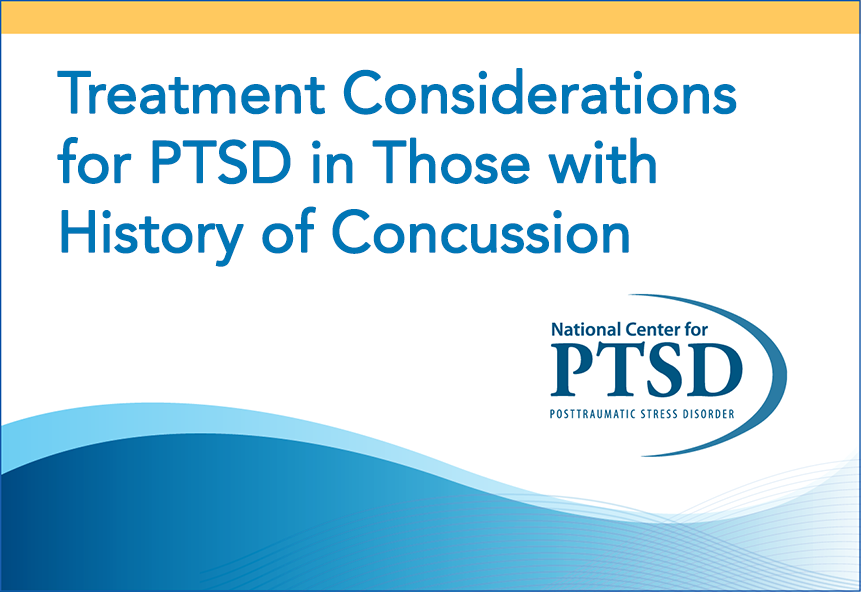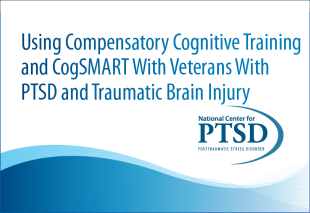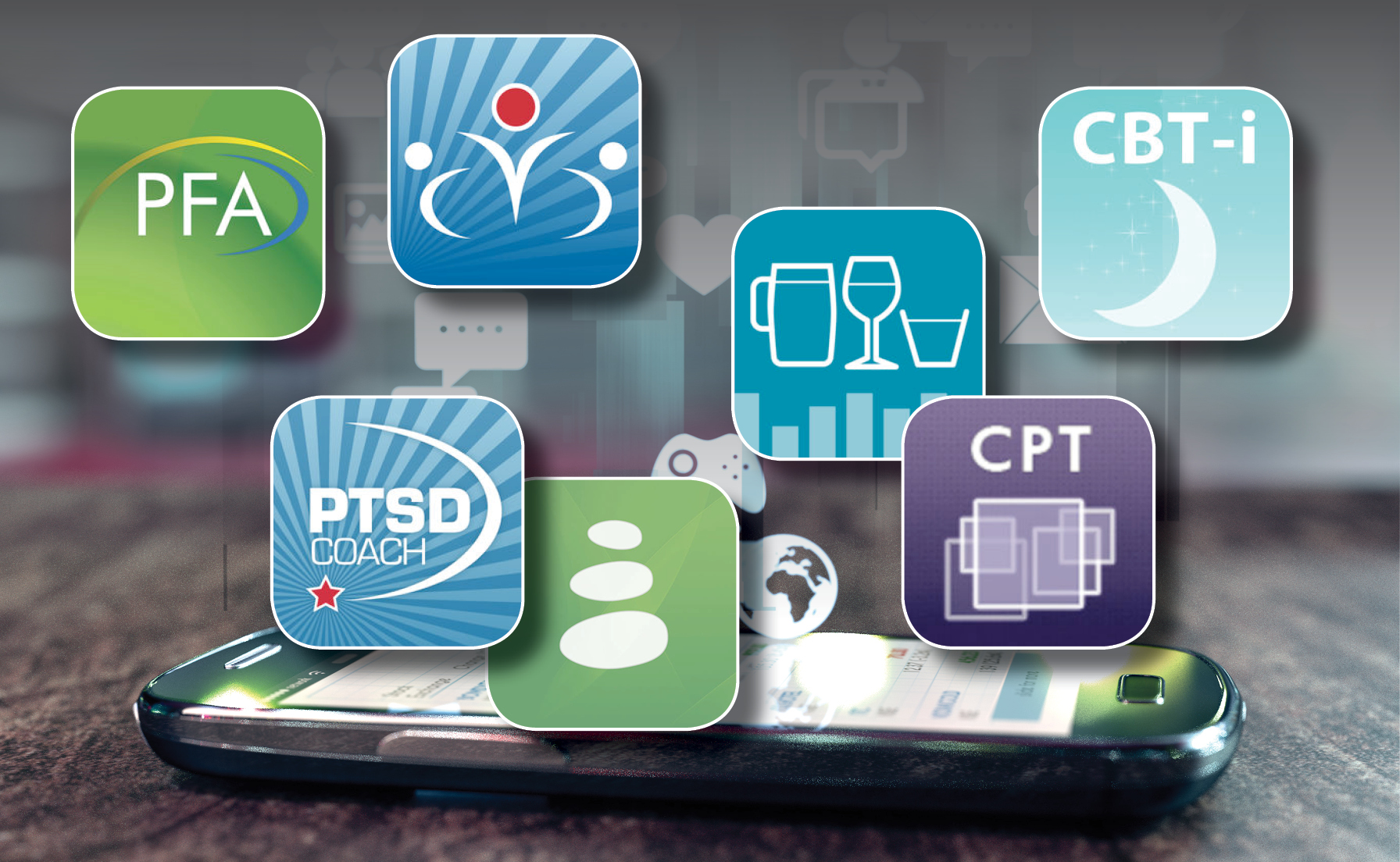Traumatic Brain Injury and PTSD
Traumatic Brain Injury and PTSD
This article outlines the different levels of traumatic brain injury (TBI) severity, how TBI and PTSD may affect each other, and what PTSD treatment may look like in the context of a history of TBI.
In This Article
What is Traumatic Brain Injury?
Traumatic brain injury (TBI) happens when an external blow to the head causes an injury or physiological disruption of brain function. TBI can occur in a military or combat context, resulting from explosion or blast injuries. For Service members or civilians, TBI can occur due to falls, motor vehicle crashes or assaults with blunt objects. TBI also happens within sports (e.g., tackle football, soccer), and may be under-recognized in the context of interpersonal violence (e.g., physical assaults).
To be defined as TBI, this injury must also include new onset or worsening of one or more of the following immediately after the injury:
- Loss or decreased level of consciousness
- Loss of memory for events immediately before or after the injury
- Alteration in mental state at the time of the injury
- Neurological deficits
- Intracranial abnormalities
Throughout this article, we refer to TBI as a historical event that is separable from the consequences or symptoms of that event (i.e. TBI-related symptoms, also referred to as post-concussive symptoms). Providers are encouraged to use the term "history of TBI" rather than "person with TBI" or "brain injury" to convey an expectation of recovery. Likewise, when the TBI is mild in severity (see below), the term "concussion" may be preferred to mild TBI (mTBI).(1)
TBI Severity Levels
TBI can be classified primarily by the severity of the injury. Importantly, factors influencing severity classification are those experienced at the time of injury or soon thereafter (e.g., length of loss of consciousness, duration of amnesia for events immediately following the injury, structural damage to the brain) vs. chronic symptoms (e.g., persistent headaches or prolonged memory complaints). Notably, TBI-related symptoms in both the acute and chronic stages of recovery may vary significantly from person to person and are not necessarily the same for people with similar severity of TBI.
TBI severity most typically is classified based on characteristics including:
- Duration of loss of consciousness (or altered consciousness, such as confusion or disorientation)
- Length of post-traumatic amnesia (PTA; a period of time during which the person cannot encode new memories)
- Glasgow Coma Scale (GCS) score
- Presence or absence of a structural, or intracranial, abnormality
Severity definitions vary slightly by source.(2) For instance, in some contexts, TBI severity is defined strictly on the basis of GCS. The Department of Veterans Affairs (VA) and Department of Defense (DoD) more commonly use loss of consciousness to define TBI severity, do not use GCS, and specify that mTBI involves no signs of brain injury on standard, clinical neuroimaging.(3) The table below outlines common, but not universal, definitions of severity aligned with VA/DoD guidelines.(4) Please note that several other classification systems exist (e.g., Mayo Classification System for TBI Severity, see National Academies of Sciences, Engineering, and Medicine, 2019 (5) for a range of classification systems).
Table of TBI severity ratings
| Severity Level | Confused / Disoriented State Lasts | Loss of Consciousness Lasts | PTA Lasts | GCS | Structural Brain Image Results |
|---|---|---|---|---|---|
| Mild | Less than 24 hours | Less than 30 minutes | Less than 24 hours | 13-15 | Not usually indicated; if taken will be normal. |
| Moderate | More than 24 hours | More than 30 minutes but less than 24 hours | More than 24 hours but less than 7 days | 9-12 | Can be normal or abnormal. A TBI can be classified as moderate if all other criteria are mild, but a CT scan is abnormal. |
| Severe | More than 24 hours | More than 24 hours | More than 7 days | 3-8 | May be normal but is typically abnormal. |
Mild TBI is sometimes further divided into complicated and uncomplicated, with complicated mTBI involving any structural abnormality identified by imaging (note that in some classification systems, this would be referred to as moderate TBI). An emerging finding is that people with an mTBI with a CT scan finding (i.e., complicated mTBI) may have a longer recovery than those with an mTBI without abnormal CT findings.(3) Newer research protocols using more sophisticated neuroimaging techniques may also identify more subtle abnormalities that are not typically reflected in the definitions above, nor identified in standard clinical care. Of the TBI severity levels, mTBI is the most common and therefore the most studied. Also, some studies have found that PTSD is more common following mTBI than moderate or severe TBI (2, 6), so much of the available research examines the overlap between mTBI and PTSD.
For more detailed information on TBI definitions, epidemiology and management, please see:
- U.S. Department of Defense: Traumatic Brain Injury
- brainline: Traumatic Brain Injury Center of Excellence (TBICoE)
- VA/DoD Clinical Practice Guideline for the Management and Rehabilitation of Post-Acute Mild Traumatic Brain Injury
- VA Rocky Mountain MIRECC: TBI Toolkit
Co-occurrence of PTSD and TBI-related Symptoms
Many of the contexts in which a TBI occurs may also be psychologically traumatic, so it is not uncommon for someone to have both TBI-related symptoms and PTSD from the same event. Indeed, injured patients with a TBI (and with multiple TBIs) are more likely to develop PTSD than those without a TBI history.(7) This correlation may be particularly relevant, for instance, in military or interpersonal violence populations, where injuries may involve both physical and psychological trauma. On the other hand, in a sport context, a TBI is not as likely to take place in the context of a psychological trauma, so there may be less overlap. Historically, there was some doubt as to whether a person with TBI who does not have a memory for the trauma could develop PTSD, but it is now understood that PTSD can develop even in the absence of a clear memory for an event causing TBI.(2,6) At times this may be because the TBI occurs in the context of a series of psychologically traumatic events (e.g., multiple blast injuries). It may also happen due to implicit (non-conscious) encoding of aspects of the event that are later triggered by associated cues. Finally, learning about and recognizing the effects of an event (e.g., awakening in a hospital emergency room) even without a clear or fully conscious memory for the event can be psychologically traumatic.
It is not yet clear why people with a history of TBI are more likely to have PTSD than those without a TBI (6,8,9), but preliminary evidence points to some possibilities.(10) First, it is possible that people with both PTSD and TBI-related symptoms had more pre-existing risk factors that influence both (e.g., prior mental health diagnoses, psychosocial and economic stress). Similarly, both PTSD and TBI-related sequelae may increase general stress on one's physiological systems that decreases overall resilience, therefore decreasing the ability to cope with either set of symptoms or to modify relevant negative cognitions. Poor sleep may be one factor mediating the relationship between injury and symptoms. TBI-related amnesia may lead to a poor encoding of the trauma memory, which may in turn lead to more re-experiencing symptoms and difficulty with processing of the trauma memory. In at least some more severe cases, TBI may cause damage to the prefrontal cortex or HPA axis, thereby leading to impaired fear extinction, poorer cognitive control over trauma-related memories, and poorer emotion regulation. Finally, PTSD and post-concussive symptoms may be bidirectionally related. For instance, the hypervigilance to risk that is a characteristic of PTSD may also predispose people to worry about somatic symptoms, thus increasing attention to them and in turn their salience.
Presentation and Assessment of PTSD with TBI-related Sequelae
Although symptoms related to more severe TBI can be relatively clear, differentiating mTBI-related symptoms from PTSD may be quite challenging. There is significant overlap in some of the more non-specific symptoms of mTBI and PTSD, including irritability, concentration difficulties, difficulty sleeping, anxiety or sadness. It is often not possible to definitively attribute self-reported symptoms and there are currently no objective measures of TBI-related sequelae or PTSD. Further, although cognitive functioning can be assessed with objective, performance-based neuropsychological tests, neuropsychological deficits are not specific to TBI-related symptoms because PTSD and any associated sleep difficulties are also often associated with neurocognitive deficits, such as in learning and memory performance. In fact, on many self-report tests, non-specific symptoms are higher for those with PTSD only than for those with a history of TBI only.(11) For these reasons, the use of self-report measures or even performance-based neuropsychological tests may not be sufficient to differentiate between disorders or to determine whether one or both are present.
A structured clinical interview should be the first tool to help tease apart PTSD from TBI-related symptom presentations.(12) A PTSD interview such as the Clinician-Administered PTSD Scale for DSM-5 (CAPS-5) can help identify the more specific PTSD symptoms (e.g., re-experiencing of a traumatic event, avoidance of reminders due to anxiety). An interview should also focus on timing of symptoms. TBI-related symptoms typically are most prominent shortly after an event and will gradually lessen over time, with likely full recovery in the majority of cases of mTBI. In contrast, PTSD symptoms may have a delayed onset and remain stable or worsen over time. Thus, if symptoms are attributed to a mTBI but worsen or remain at the same level beyond the acute phase of post-injury recovery, it is possible that PTSD or other psychological sequelae may be contributing to them.
In those cases in which PTSD is clearly present, and the non-specific symptoms are unclearly related to either PTSD and/or TBI-related symptoms, it may not be possible to definitively assess whether some of the non-specific symptoms are indeed related to TBI. Moreover, it may not be of the most clinical importance to the treatment plan. This is because PTSD treatments that most effectively treat PTSD have also been shown to address many non-specific symptoms that may be (mis)attributed to TBI.(13)
Treatment of Co-Occurring PTSD and TBI-related Symptoms
When a patient has comorbid PTSD and mTBI-related symptoms, they may attribute these symptoms to consequences of the TBI rather than PTSD. However, regardless of whether TBI is contributing to the symptoms, it is important to collaboratively identify with patients when PTSD is part of the clinical picture because PTSD is not likely to get better without treatment and can exacerbate or masquerade as many of the symptoms the patient might attribute to post-concussive symptoms (e.g., neurocognitive deficits).(14) For this reason, the VA/DoD Clinical Practice Guideline for the Management and Rehabilitation of Post-Acute Mild Traumatic Brain Injury recommends setting expectations of recovery with patients and referring them to treatment for any comorbid conditions.(1) A solid therapeutic relationship is important for having conversations about symptom attribution and treatment. Clinicians should convey that symptoms are real but may not be solely related to a mTBI, and that, in those cases where PTSD is present, treatment of PTSD may significantly help with both PTSD and non-specific symptoms.(15) Collaboratively discuss with patients that many symptoms of these 2 conditions overlap, that PTSD treatment can help to address many symptoms that may exacerbate cognitive difficulties, and any residual cognitive difficulties will be addressed following PTSD treatment.
Continuing Education Course
Treatment Considerations for PTSD in Those with History of Concussion
This PTSD 101 online course discusses research support for the use of trauma-focused therapies for those with co-occurring PTSD and mTBI.
Research on treatment for patients with PTSD and post-concussive symptoms is somewhat limited. Available evidence suggests that patients with PTSD and a history of TBI, even moderate-to-severe, do as well in the most recommended treatments for PTSD—mainly Cognitive Processing Therapy (CPT) and Prolonged Exposure (PE)—as those without a history of TBI. Some studies have examined secondary analyses of outpatient PTSD treatment, retrospectively comparing those with TBI-related symptoms to those without, generally finding little difference in PTSD outcomes.(16-20) Other studies have documented improvements in those receiving PTSD treatment within a residential program that also offer other treatments, including cognitive rehabilitation, simultaneously (21-23). This body of research has 3 main limitations: 1) much of the research involving program evaluation or secondary analysis was not designed to compare the effectiveness of different treatments or to compare modified to unmodified treatments; 2) often PTSD treatment in residential programs was offered alongside other non-PTSD treatments, making it difficult to determine whether the PTSD treatment alone would be helpful; and, 3) most of the research has involved those with a history of mTBI, with much less direct evidence for those with moderate to severe TBI.
One study (13) addressed some of the above limitations by comparing CPT alone to SMART-CPT, a treatment combining CPT and compensatory cognitive training.(24) The sample included Veterans with PTSD and a history of mild-to-moderate TBI. Both conditions led to significant reductions in PTSD and TBI-related symptoms while improving quality of life. The SMART-CPT condition led to additional improvements in attention, verbal learning and problem-solving, but did not lead to additional PTSD symptom reduction. Secondary analyses of this study indicated that Veterans who had poorer baseline executive functioning were more likely to drop out of—or have less improvement in--either treatment arm.(25) However, characteristics of the TBI itself did not predict treatment outcome.(26)
Continuing Education Course
Using Compensatory Cognitive Training and CogSMART for Veterans With PTSD and Traumatic Brain Injury
This PTSD 101 online course reviews Compensatory Cognitive Training (CCT) and CogSMART for individuals with neuropsychiatric conditions, including TBI, and PTSD.
Clinicians should combine knowledge of their patients with the existing literature to inform treatment planning for their patients. Start with a recommended PTSD treatment without modifications, adding those only as needed or indicated. So long as patients who experienced more severe TBI are able to retain information and function independently, then a trauma-focused treatment should still be appropriate for them. If a neuropsychological examination is available (27), and cognitive deficits appear to be getting in the way of treatment, it may be useful to pursue protocol-consistent modifications to treatment. Those could include:
- Providing external memory aids such as written calendars or smartphone reminders to prompt for homework completion or session attendance.
- Reinforcing concepts by simplifying worksheets, using visual or written descriptions of concepts, encouraging recording of sessions, extending session time—especially for cognitively challenging work—or using teach-back methods to gauge understanding.
- Modifying sessions by using repetition, increasing the structure of session content, or taking breaks within sessions.
- Problem-solving to address cognitive deficits if they continue to interfere.
- Including supportive others in sessions. If family or close friends can learn about PTSD and TBI, they may feel validation of their experiences, better understand their significant other, and be more able to assist in the recovery process in various ways, including reinforcing therapy homework or material.
- Conducting imaginal exposure during PE using the existing fragments of memory organized into as cohesive a memory as possible, even if there is not a full, cohesive trauma memory.(28,29)
- Collaborating with other members of the health care team, to include speech-language pathologists, physical therapists, occupational therapists, and/or case managers, and to encourage a consistent narrative of recovery to convey the expectation that conditions can improve.(30)
There is relatively less research on best practices for prescribing medications for those with PTSD and TBI-related sequelae.(6) As with psychotherapy, start with a recommended PTSD treatment, generally an SSRI or SNRI. When TBI sequelae are present, start with a low dose, titrating slowly, and be aware of the potential for medications to exacerbate symptoms or cause side effects such as agitation, sleep disturbance, or cognitive deficits.
Conclusion
Though identification and definition of TBI may vary in civilian versus Veteran settings, recommendations for assessment and treatment of PTSD in the context of a history of TBI are largely the same. Structured clinical interviews can help to tease apart symptoms. Available evidence suggests that PTSD treatment can be effective for those with TBI-related sequelae, with some suggestions for modifications as needed.
References
- Department of Veterans Affairs and Department of Defense. (2021). VA/DoD Clinical Practice Guideline for the Management and Rehabilitation of Post-Acute Mild Traumatic Brain Injury. https://www.healthquality.va.gov/guidelines/Rehab/mtbi/VADoDmTBICPGFinal508.pdf
- Howlett, J. R., Nelson, L. D., & Stein, M. B. (2021). Mental health consequences of traumatic brain injury. Biological Psychiatry, 91(5), 413-420. https://doi.org/10.1016/j.biopsych,2021.09.024
- Yuh, E. L., Jain, S., Sun, X., Pisică , D., Harris, M. H., Taylor, S. R., Markowitz, A. J., Mukherjee, P., Verheyden, J., Giacino, J. T., Levin, H. S., McCrea, M., Stein, M. B., Temkin, N. R., Diaz-Arrastia, R., Robertson, C. S., Lingsma, H. F., Okonkwo, D. O., Maas, A. I. R., Manley, G. T., & the TRACK-TBI Study With External Validation in CENTER-TBI. (2021). Pathological computed tomography features associated with adverse outcomes after mild traumatic brain injury: A TRACK-TBI study with external validation in CENTER-TBI. JAMA neurology, 78(9), 1137-1148. https://doi.org/10.1001/jamaneurol.2021.2120
- Assistant Secretary of Defense. (2015, April 6). Traumatic brain injury: Updated definition and reporting. Washington, DC: Department of Defense. Available from: https://www.health.mil/Reference-Center/Policies/2015/04/06/Traumatic-Brain-Injury-Updated-Definition-and-Reporting.
- National Academies of Sciences, Engineering, and Medicine; Health and Medicine Division; Board on Health Care Services; Committee on the Review of the Department of Veterans Affairs Examinations for Traumatic Brain Injury in Veterans. (2019). Diagnosis and Assessment of Traumatic Brain Injury. In, Evaluation of the Disability Determination Process for Traumatic Brain Injury in Veterans. National Academies Press. Available from: https://www.ncbi.nlm.nih.gov/books/NBK542595/
- Vasterling, J. J., Jacob, S. N., & Rasmusson, A. (2018). Traumatic brain injury and posttraumatic stress disorder: Conceptual, diagnostic, and therapeutic considerations in the context of co-occurrence. Journal of Neuropsychiatry and Clinical Neurosciences, 30(2), 90-100. https://doi.org/10.1176/appi.neuropsych.17090180
- Loignon, A., Ouellet, M. C., & Belleville, G. (2020). A systematic review and meta-analysis on PTSD following TBI among military/Veteran and civilian populations. The Journal of Head Trauma Rehabilitation, 35(1), E21-E35. https://doi.org/10.1097/HTR.0000000000000514
- Alosco, M. L., Supelana, C. J., & Vasterling, J. J. (2017). Traumatic brain injury and psychological trauma. In S.N. Gold (Ed.), APA handbook of trauma psychology: Foundations in knowledge, Vol. 1 (pp. 333-347). American Psychological Association. https://doi.org/10.1037/0000019-000
- Albrecht, J. S., Abariga, S. A., Rao, V., & Wickwire, E. M. (2020). Incidence of new neuropsychiatric disorder diagnoses following traumatic brain injury. The Journal of Head Trauma Rehabilitation, 35(4), E352-E360. https://doi.org/10.1097/HTR.0000000000000551
- Hayes, J. P. (2019). PTSD and TBI Comorbidity. PTSD Research Quarterly, 30(2). Available from: https://www.ptsd.va.gov/publications/rq_docs/V30N2.pdf
- Merritt, V. C., Jurick, S. M., Crocker, L. D., Hoffman, S. N., Keller, A. V., DeFord, N., & Jak, A. J. (2019). Evaluation of objective and subjective clinical outcomes in combat veterans with and without mild TBI and PTSD: A four-group design. Journal of clinical and experimental neuropsychology, 41(7), 665-679. https://doi.org/10.1080/13803395.2019.1610161
- Rosen, V., & Ayers, G. (2020). An update on the complexity and importance of accurately diagnosing post-traumatic stress disorder and comorbid traumatic brain injury. Neuroscience Insights, 15. https://doi.org/10.1177/2633105520907895
- Jak, A. J., Jurick, S., Crocker, L. D., Sanderson-Cimino, M., Aupperle, R., Rodgers, C. S., Thomas, K. R., Boyd, B., Norman, S. B., Lang, A. J., Keller, A. V., Schiehser, D. M., & Twamley, E. W. (2019). SMART-CPT for veterans with comorbid post-traumatic stress disorder and history of traumatic brain injury: a randomised controlled trial. Journal of Neurology, Neurosurgery & Psychiatry, 90(3), 333-341. https://doi.org/10.1136/jnnp-2018-319315
- Kenna, A. C., Barber, C., Rasmusson, A., Resick, P., Milberg, W., & McGlinchey, R. (2012). Treatment for co-occurring posttraumatic stress disorder and traumatic brain injury. In R. A. McMackin, E. Newman, J. M. Fogler, & T. M. Keane (Eds.), Trauma therapy in context: The science and craft of evidence-based practice (pp. 313-330). American Psychological Association. https://doi.org/10.1037/13746-015
- Wolf, G. K., Mauntel, G. J., Kretzmer, T., Crawford, E., Thors, C., Strom, T. Q., & Vanderploeg, R. D. (2018). Comorbid posttraumatic stress disorder and traumatic brain injury: Generalization of prolonged-exposure PTSD treatment outcomes to postconcussive symptoms, cognition, and self-efficacy in Veterans and active duty Service members. Journal of Head Trauma Rehabilitation, 33(2), E53-E63. https://doi.org/10.1097/HTR.0000000000000344
- Davis, J. J., Walter, K. H., Chard, K. M., Parkinson, R. B., & Houston, W. S. (2013). Treatment adherence in Cognitive Processing Therapy for combat-related PTSD with history of mild TBI. Rehabilitation Psychology, 58(1), 36-42. https://doi.org/10.1037/a0031525
- Ragsdale, K. A., & Voss Horrell, S. C. (2016). Effectiveness of Prolonged Exposure and Cognitive Processing Therapy for US Veterans with a history of traumatic brain injury. Journal of Traumatic Stress, 29(5), 474-477. https://doi.org/10.1002/jts.22130
- Sripada, R. K., Rauch, S. A. M., Tuerk, P. W., Smith, E., Defever, A. M., Mayer, R. A., Messina, M., & Venners, M. (2013). Mild traumatic brain injury and treatment response in Prolonged Exposure for PTSD. Journal of Traumatic Stress, 26(3), 369-375. https://doi.org/10.1002/jts.21813
- Wolf, G. K., Kretzmer, T., Crawford, E., Thors, C., Wagner, H. R., Strom, T. Q., Eftechari, A., Klenk, M., Hayward, L., & Vanderploeg, R. D. (2015). Prolonged Exposure therapy with Veterans and active duty personnel diagnosed with PTSD and traumatic brain injury. Journal of Traumatic Stress, 28(4), 339-347. https://doi.org/10.1002/jts22029
- Crawford, E. F., Wolf, G. K., Kretzmer, T., Dillon, K. H., Thors, C., & Vanderploeg, R. D. (2017). Patient, therapist, and system factors influencing the effectiveness of Prolonged Exposure for Veterans with comorbid posttraumatic stress disorder and traumatic brain injury. The Journal of Nervous and Mental Disease, 205(2), 140-146. https://doi.org/10.1097/NMD.0000000000000594
- Chard, K. M., Schumm, J. A., McIlvain, S. M., Bailey, G. W., & Parkinson, R. B. (2011). Exploring the efficacy of a residential treatment program incorporating Cognitive Processing Therapyâ€Cognitive for Veterans with PTSD and traumatic brain injury. Journal of Traumatic Stress, 24(3), 347-351. https://doi.org/10.1002/jts.20644
- Harvey, M. M., Petersen, T. J., Sager, J. C., Makhija-Graham, N. J., Wright, E. C., Clark, E. L., Laifer, L. M., Richards, L. K., Chow, L. K., Sylvia, L. G., Lento, R. M., Harward, L. K., Clowes, J., Brathwaite, V., Lakin, L. K., Silververg, N. D., Iverson, G., L., Bui, E., & Simon, N. M. (2019). An intensive outpatient program for Veterans with posttraumatic stress disorder and traumatic brain injury. Cognitive and Behavioral Practice, 26(2), 323-334. https://doi.org/10.1016/j.cbpra.2018.07.003
- Walter, K. H., Dickstein, B. D., Barnes, S. M., & Chard, K. M. (2014). Comparing effectiveness of CPT to CPTâ€C among US Veterans in an interdisciplinary residential PTSD/TBI treatment program. Journal of Traumatic Stress, 27(4), 438-445. https://doi.org/10.1002/jts.21934
- Jak, A. (2019, September 18). Treating co-morbid PTSD and traumatic brain injury when cognitive impairment is a concern. PTSD Consultation Program Lecture Series. https://www.ptsd.va.gov/professional/consult/lecture_series.asp
- Crocker, L. D., Jurick, S. M., Thomas, K. R., Keller, A. V., Sanderson-Cimino, M., Boyd, B., Rodgers, C., Twamley, E. W., & Jak, A. J. (2018). Worse baseline executive functioning is associated with dropout and poorer response to trauma-focused treatment for veterans with PTSD and comorbid traumatic brain injury. Behaviour research and therapy, 108, 68-77. https://doi.org/10.1016/j.brat.2018.07.004
- Crocker, L. D., Jurick, S. M., Thomas, K. R., Keller, A. V., Sanderson-Cimino, M., Hoffman, S. N., Boyd, B., Rodgers, C., Norman, S. B., Lang, A. J., Twamley, E. W., & Jak, A. J. (2019). Mild traumatic brain injury characteristics do not negatively influence Cognitive Processing Therapy attendance or outcomes. Journal of Psychiatric Research, 116, 7-13. https://doi.org/10.1016/j.jpsychires.2019.05.022
- Turner, K. A., Smith, A. J., Jones, R. T., & Harrison, D. W. (2018). Adapting Cognitive Processing Therapy to treat co-occurring posttraumatic stress disorder and mild traumatic brain injury: A case study. Cognitive and Behavioral Practice, 25(2), 261-274. https://doi.org/10.1016/j.cbpra.2017.06.003
- Ragsdale, K. A., Gramlich, M. A., Beidel, D. C., Neer, S. M., Kitsmiller, E. G., & Morrison, K. I. (2018). Does traumatic brain injury attenuate the exposure therapy process? Behavior Therapy, 49(4), 617-630. https://doi.org/10.1016/j.beth.2017.09.008
- Strom, T. Q., Wolf, G. K., Crawford, E., Blahnik, M., & Kretzmer, T. (2016). Implementing Prolonged Exposure for Veterans with comorbid PTSD and traumatic brain injury: Two case studies. Cognitive and Behavioral Practice, 23(2), 148-161. https://doi.org/10.1016/j.cbpra,2015.03.003
- Corrigan, J. D. (2021). Traumatic brain injury and treatment of behavioral health conditions. Psychiatric Services, 72(9), 1057-1064. https://doi.org/10.1176/appi.ps.201900561
You May Also Be Interested In

Continuing Education Online Courses
Learn from expert researchers and earn free Continuing Education (CE) credits.



























